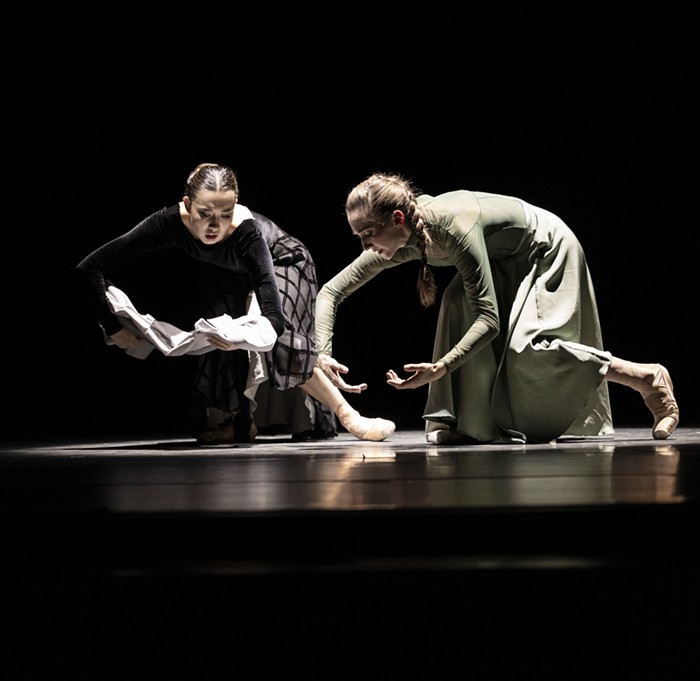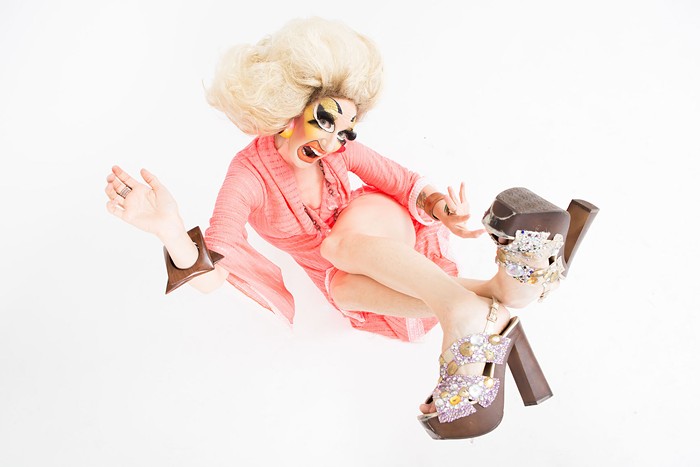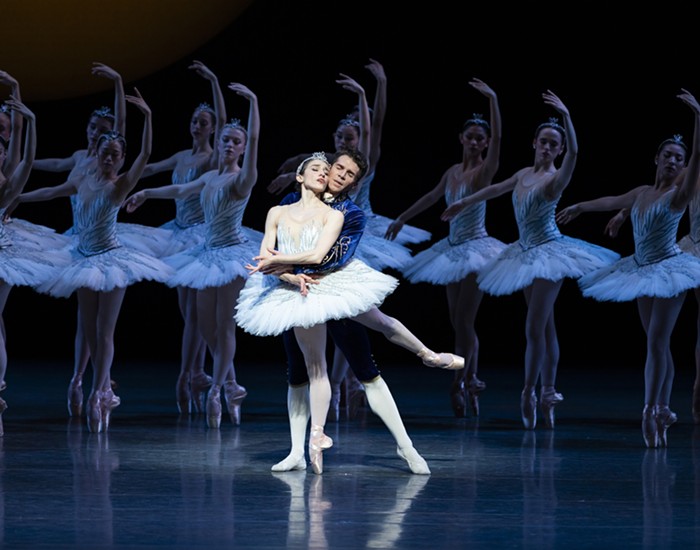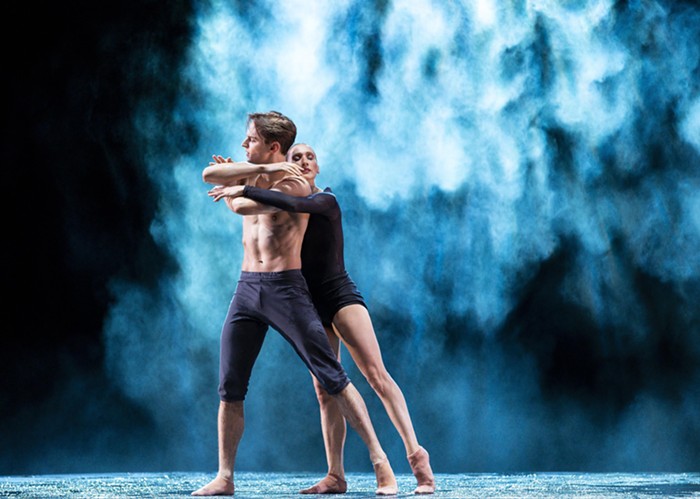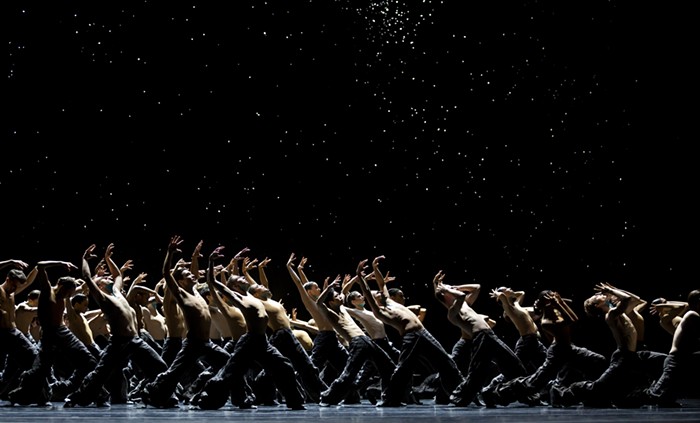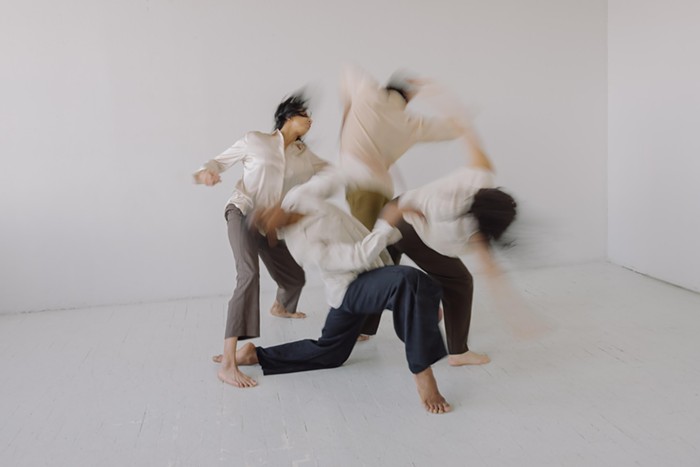
Two surface-y, non-dance choices framed PNB's American Stories in a way that made it difficult to get excited about. 1. Those advertisements. 2. That title.
As for Gripe #1: Happily, the ballets in the show are infinitely more interesting than the J.C. Penney-inspired advertisements used to promote it.
As for Gripe #2: A number of automatic postmodern follow-up questions leap to mind the moment an organization uses "American" in the title of anything. I know it's insufferable, but I can't help myself from thinking whose America what America why America what do you even mean by America how can a story even be "American" which America? south America? central America? north America? And how is the ballet going to address all of this political complexity?
To let me know that they knew that I was going to ask those questions in my mind, PNB published in the show's program a small collection of stories from people from diverse backgrounds, such as local choreographer Kate Wallich, 10th-ever US woman commercial pilot Stephanie Wallach, PNB orchestra concert member Michael Jinsoo Lim, and dancer/steadfast dance community member/trans woman Anne A. Lawrence. Many of the stories are moving, and many of the people who wrote them shared my suspicion of the term "American story."
The American stories being presented on the stage also do their part to answer my questions. Those stories come from Russian immigrant George Balanchine, Jewish-American Jerome Robbins, and living legend from small-town Indiana, Twyla Tharp. All amazing, massively influential choreographers. And each of their stories, if you look close enough, reveals a deep and semi-subversive truth about Uncle Sam.
The evening begins with Robbins' Fancy Free, which is a bouncy and easygoing piece set to music by Leonard Bernstein about sailors on temporary leave from WWII. Three sailors knock back beers at a bar and pretend they're not about to make out with each other until a woman (2016 Stranger Genius Nominee Noelani Pantastico) walks by with a bright red bag and distracts them with her beauty. In an attempt to woo her, the sailors initiate an incredibly elegant game of keep-away, during which Pantastico beats them all up using a series of slapstick moves.

When a second woman walks by, the men engage in a ballerino dance-off to compete for their affections. The dance gives Seth Orza, Jonathan Porretta, and especially James Moore the opportunity to show off their insane athleticism. High jumps happen. High jumps that end in splits happen. Lots of muscular peacocking happens. Who wins? The audience. What does all this tell us about America? War ruins everything. In addition to mass death and displacement, its impositions reduce flirting and socialization to a brutally competitive self-defeating shark tank where time is short and love is scarce.
Balanchine's Square Dance was set in front of a glowing blue square. The men wore pants that looked like lavender condoms and the women wore satin dinner napkins. Through their "shirts" you could see the tortoiseshell abs of the men and the long, lean muscles of the women. They were all moving marble. Leta Biasucci and Benjamin Griffiths performed a slow-mo pas de deux that seemed impossible considering the demands of gravity. They embodied the amount of strength and grace and restraint necessary to actually love someone. Also: The footwork in this one is bonkers, revealing the complexity and beauty buried in a dance that's often dismissed as simple, stiff, folk-y party dancing.

There was a stumble, though! Some small tragedy brought Chelsea Adomaitis to the ground with a thud. I only barely caught it because the moment was camouflaged by the bodies of other dancers on the stage, but those higher up saw it and gasped.
The gossip in the press room was too hot to handle, but from what I gathered the fault was with the dancer's partner. PNB PR Guy, Gary Tucker, told me Adomaitis was up and laughing about it backstage.
I loved seeing the fall, especially in a piece that requires so much control and technical prowess. A tumble seemed so appropriate given the theme: the American dream is impossible to attain, and dangerous, and certainly unsustainable. And yet, emotionally I feel what Bill Callahan feels: "One thing about this wild, wild country/ It takes a strong, strong/ It breaks a strong, strong mind./But anything less, anything less/ Makes me feel like I'm wasting my time."
Twyla Tharp's Waiting at the Station closed out the night. This one's a swinging jazzy number with music from Allen Toussaint. The narrative involves a father (Moore) teaching his son (Price Suddarth) some dance steps in anticipation of his own death. The music drops you into New Orleans—your body relaxes, you get a little happy-lonesome-sad, and you reach for a non-existent sazerac.
All the movements in Waiting are sweeping and exaggerated. Male dancers throw and lift women dancers up real high. Three Fates (Chelsea Adomaitis, Elle Macy, Sarah Pasch) wearing bizarre golden shower nets lift Moore and throw him around. Speaking of Moore, he stuns in this one, too, with a lot of hat tricks and shimmy-intensive gamboling. A quartet of dancers swirl around and play out a romantic B-story that involves a lot of difficult-looking, graceful drunken stumbles. This video of Pantastico moving her body in ~15 different directions within 15 seconds will give you an idea of what I'm talking about:
But what does Waiting at the Station tell us about America? Americans hand down misery to Americans. They also hand down its antidotes.

